Information on the July-94 "Palm" Fire
The following is a late July 1994
accounting of the July-94 fire which burned through the
observatory.
After the short text is a list of photos.
We had a most exciting
Fourth-of-July (1994) weekend at Pinon Flat Observatory. We had a not-so-
small ``brush'' fire (officially 19,200 acres - 30 square miles)
sweep through the
observatory, pushed by strong winds and with a flame front estimated
at 50 feet high. Since that time we've been scrambling to make
sense of the damage and to restore what we could as quickly as possible.
Amazingly, nearly all the critical structures were saved -- we are
thus extremely grateful to the fire-fighters. The things that were
severely damaged were mostly those elements of the site that extended
laterally above ground, there being no way to defend the long lines.
This means some of the power distribution, much of the signal wiring
outside the area of the central-recording facilities, and ~35% of
the long-base laser strainmeter vacuum pipes were destroyed by the fire.
Only a few instrumented vaults were destroyed.
The site, away from the areas that
were defended by the fire fighters
and away from the areas immediately downwind of the
defended structures, now has the look of lunar landscape. About 30
to 40% of the site is burned.
The fire-fighters -- there must have been two dozen or more crews
at the site when the fire came through in the night -- evidently
positioned themselves between the oncoming flames and each structure
they chose to protect, and their strategy worked incredibly well.
We now understand much more about this kind of fire, and how
hard it is to gain control when the winds push the flames. We
understand especially that it's not so much things catching on fire
that's the big problem (at least when you have as many crews in
action as this fire did, 3,000-plus people; they just axed away at
odds and ends that were on fire), but rather the incredible heat
given off as trees and thick bushes burst into flames. Signal wire,
vacuum pipes and the like were partially melted wherever a tree or
substantial bush was close by. When we first arrived at the
site we found many (~60)
sections of the strainmeter vacuum pipe sucked flat by the
combination of the incredible heat and the vacuum inside the pipe.
All instrumentation was off-the-air when we first were allowed into the area,
almost two days after the main fire - with small fires still underway
in various places around the site. The power was off everywhere with
most of the circuit breakers tripped on account of the power cabling having
been melted in a number of places; the standby automated motor-
generator was happily running with no load. Within 24 hours we
succeeded in getting the power restored to most of the site, and the
power company restored power to the mains (they had to replace poles,
wires, and transformers). By week's end phone
service was restored and we'd done the patch work to have the seismic
and GPS receivers up and running. Both structures that housed the
(2) permanent GPS receivers got singed, but escaped without serious damage.
The antennas were in fine shape. We were lucky there.
At this point we're focusing on rerouting key signals from working
instruments to the recording trailer, using undamaged lines. We estimate
the site
is about 50-70% functional; the one key bit of instrumentation that's
not working, and will remain so until we spend some serious dollars
in the machine-shop, are the laser strainmeters. [With University
support all of these were rebuilt within the next two years.]
Fortunately none of the critical components of these systems
(the optical/laser/vacuum equipment in the end-vaults)
were damaged in the slightest. All the
components that would have required many months of skilled effort to
rebuild survived.
Photos from the July-94 brushfire
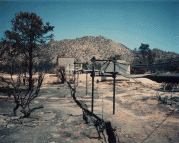 Vacuum pipes from the University of California San Diego (UCSD)
NS Laser Strain Meter (LSM) (342 KBytes)
Vacuum pipes from the University of California San Diego (UCSD)
NS Laser Strain Meter (LSM) (342 KBytes)
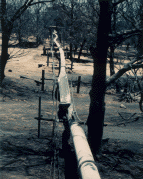 The UCSD EW LSM at the east end (369 KBytes)
The UCSD EW LSM at the east end (369 KBytes)
 The UCSD NW/SE LSM viewed from the SE end (326 KBytes)
The UCSD NW/SE LSM viewed from the SE end (326 KBytes)
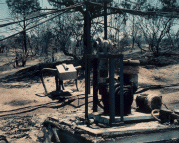 Vacuum pump along the UCSD NW/SE LSM (381 KBytes)
Vacuum pump along the UCSD NW/SE LSM (381 KBytes)
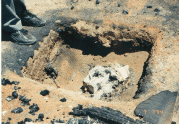 Remains of the Kyushu University (Japan) magnetometer (93 KBytes)
Remains of the Kyushu University (Japan) magnetometer (93 KBytes)
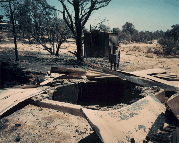 Above ground view of Lamont-Doherty Geophiyical Observaroty (LDGO)
tiltmeter vault (west end) (333 KBytes)
Above ground view of Lamont-Doherty Geophiyical Observaroty (LDGO)
tiltmeter vault (west end) (333 KBytes)
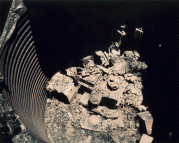 Below ground view of LDGO tiltmeter vault (west end) (333 KBytes)
Back to PFO home page
Below ground view of LDGO tiltmeter vault (west end) (333 KBytes)
Back to PFO home page
 Vacuum pipes from the University of California San Diego (UCSD)
NS Laser Strain Meter (LSM) (342 KBytes)
Vacuum pipes from the University of California San Diego (UCSD)
NS Laser Strain Meter (LSM) (342 KBytes)
 The UCSD EW LSM at the east end (369 KBytes)
The UCSD EW LSM at the east end (369 KBytes)
 The UCSD NW/SE LSM viewed from the SE end (326 KBytes)
The UCSD NW/SE LSM viewed from the SE end (326 KBytes)
 Vacuum pump along the UCSD NW/SE LSM (381 KBytes)
Vacuum pump along the UCSD NW/SE LSM (381 KBytes)
 Remains of the Kyushu University (Japan) magnetometer (93 KBytes)
Remains of the Kyushu University (Japan) magnetometer (93 KBytes)
 Above ground view of Lamont-Doherty Geophiyical Observaroty (LDGO)
tiltmeter vault (west end) (333 KBytes)
Above ground view of Lamont-Doherty Geophiyical Observaroty (LDGO)
tiltmeter vault (west end) (333 KBytes)
 Below ground view of LDGO tiltmeter vault (west end) (333 KBytes)
Back to PFO home page
Below ground view of LDGO tiltmeter vault (west end) (333 KBytes)
Back to PFO home page